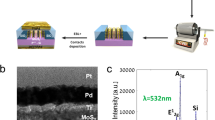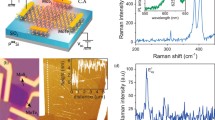Abstract
Group-IV monochalcogenides are emerging as a new class of layered materials beyond graphene, transition metal dichalcogenides (TMDCs), and black phosphorus (BP). In this paper, we report experimental and theoretical investigations of the band structure and transport properties of GeSe and its heterostructures. We find that GeSe exhibits a markedly anisotropic electronic transport, with maximum conductance along the armchair direction. Density functional theory calculations reveal that the effective mass is 2.7 times larger along the zigzag direction than the armchair direction; this mass anisotropy explains the observed anisotropic conductance. The crystallographic orientation of GeSe is confirmed by angleresolved polarized Raman measurements, which are further supported by calculated Raman tensors for the orthorhombic structure. Novel GeSe/MoS2 p-n heterojunctions are fabricated, combining the natural p-type doping in GeSe and n-type doping in MoS2. The temperature dependence of the measured junction current reveals that GeSe and MoS2 have a type-II band alignment with a conduction band offset of ∼0.234 eV. The anisotropic conductance of GeSe may enable the development of new electronic and optoelectronic devices, such as high-efficiency thermoelectric devices and plasmonic devices with resonance frequency continuously tunable through light polarization direction. The unique GeSe/MoS2 p-n junctions with type-II alignment may become essential building blocks of vertical tunneling field-effect transistors for low-power applications. The novel p-type layered material GeSe can also be combined with n-type TMDCs to form heterogeneous complementary metal oxide semiconductor (CMOS) circuits.

Similar content being viewed by others
References
Zhao, L. D.; Lo, S. H.; Zhang, Y. S.; Sun, H.; Tan, G. J.; Uher, C.; Wolverton, C.; Dravid, V. P.; Kanatzidis, M. G. Ultralow thermal conductivity and high thermoelectric figure of merit in SnSe crystals. Nature 2014, 508, 373–377.
Ding, G. Q.; Gao, G. Y.; Yao, K. L. High-efficient thermoelectric materials: The case of orthorhombic IV-VI compounds. Sci. Rep. 2015, 5, 9567.
Chattopadhyay, T.; Pannetier, J.; Von Schnering, H. G. Neutron diffraction study of the structural phase transition in SnS and SnSe. J. Phys. Chem. Solids 1986, 47, 879–885.
Vaughn, D. D., II.; Patel, R. J.; Hickner, M. A.; Schaak, R. E. Single-crystal colloidal nanosheets of GeS and GeSe. J. Am. Chem. Soc. 2010, 132, 15170–15172.
Singh A. K.; Hennig, R. G. Computational prediction of two-dimensional group-IV mono-chalcogenides. Appl. Phys. Lett. 2014, 105, 042103.
Taniguchi, M.; Johnson, R. L.; Ghijsen, J.; Cardona, M. Core excitons and conduction-band structures in orthorhombic GeS, GeSe, SnS, and SnSe single crystals. Phys. Rev. B 1990, 42, 3634–3643.
Makinistian, L.; Albanesi, E. A. Ab initio calculations of the electronic and optical properties of germanium selenide. J. Phys.: Condens. Matter 2007, 19, 186211.
Gomes, L. C.; Trevisanutto, P. E.; Carvalho, A.; Rodin, A. S.; Neto, A. H. C. Strongly bound Mott-Wannier excitons in GeS and GeSe monolayers. Phys. Rev. B 2016, 94, 155428.
Asanabe, S.; Okazaki, A. Electrical properties of germanium selenide GeSe. J. Phys. Soc. Jpn. 1960, 15, 989–997.
Mehboudi, M.; Fregoso, B. M.; Yang, Y. R.; Zhu, W. J.; van der Zande, A.; Ferrer, J.; Bellaiche, L.; Kumar, P.; Barraza-Lopez, S. Structural phase transition and material properties of few-layer monochalcogenides. Phys. Rev. Lett. 2016, 117, 246802.
Mukherjee, B.; Cai, Y. Q.; Tan, H. R.; Feng, Y. P.; Tok, E. S.; Sow, C. H. NIR schottky photodetectors based on individual single-crystalline GeSe nanosheet. ACS Appl. Mater. Interfaces 2013, 5, 9594–9604.
Yoon, S. M.; Song, H. J.; Choi, H. C. p-type semiconducting GeSe combs by a vaporization-condensation-recrystallization (VCR) process. Adv. Mater. 2010, 22, 2164–2167.
Mehboudi, M.; Dorio, A. M.; Zhu, W. J.; van der Zande, A.; Churchill, H. O. H.; Pacheco-Sanjuan, A. A.; Harriss, E. O.; Kumar, P.; Barraza-Lopez, S. Two-dimensional disorder in black phosphorus and monochalcogenide monolayers. Nano Lett. 2016, 16, 1704–1712.
Gomes, L. C.; Carvalho, A. Phosphorene analogues: Isoelectronic two-dimensional group-IV monochalcogenides with orthorhombic structure. Phys. Rev. B 2015, 92, 085406.
Takagi, S.; Toriumi, A.; Iwase, M.; Tango, H. On the universality of inversion layer mobility in Si MOSFET’s: Part II-effects of surface orientation. IEEE Trans. Electron Dev. 1994, 41, 2363–2368.
Bruzzone, S.; Fiori, G. Ab-initio simulations of deformation potentials and electron mobility in chemically modified graphene and two-dimensional hexagonal boron-nitride. Appl. Phys. Lett. 2011, 99, 222108.
Fei, R. X.; Yang, L. Strain-engineering the anisotropic electrical conductance of few-layer black phosphorus. Nano Lett. 2014, 14, 2884–2889.
Ling, X.; Wang, H.; Huang, S. X.; Xia, F. N.; Dresselhaus, M. S. The renaissance of black phosphorus. Proc. Natl. Acad. Sci. USA 2015, 112, 4523–4530.
Low, T.; Roldán, R.; Wang, H.; Xia, F. N.; Avouris, P.; Moreno, L. M.; Guinea, F. Plasmons and screening in monolayer and multilayer black phosphorus. Phys. Rev. Lett. 2014, 113, 106802.
Xia, F. N.; Wang, H.; Jia, Y. C. Rediscovering black phosphorus as an anisotropic layered material for optoelectronics and electronics. Nat. Commun. 2014, 5, 4458.
Fei, R. X.; Faghaninia, A.; Soklaski, R.; Yan, J. A.; Lo, C.; Yang, L. Enhanced thermoelectric efficiency via orthogonal electrical and thermal conductances in phosphorene. Nano Lett. 2014, 14, 6393–6399.
Chandrasekhar, H. R.; Zwick, U. Raman scattering and infrared reflectivity in GeSe. Solid State Commun. 1976, 18, 1509–1513.
Fukunaga, T.; Sugai, S.; Kinosada, T.; Murase, K. Observation of new Raman lines in GeSe and SnSe at low temperatures. Solid State Commun. 1981, 38, 1049–1052.
Xia, J.; Li, X. Z.; Huang, X.; Mao, N. N.; Zhu, D. D.; Wang, L.; Xu, H.; Meng, X. M. Physical vapor deposition synthesis of two-dimensional orthorhombic SnS flakes with strong angle/temperature-dependent Raman responses. Nanoscale 2016, 8, 2063–2070.
Powell, R. C. Symmetry, Group Theory, and the Physical Properties of Crystals; Springer: New York, 2010.
Suh, J.; Park, T. E.; Lin, D. Y.; Fu, D. Y.; Park, J.; Jung, H. J.; Chen, Y. B.; Ko, C.; Jang, C.; Sun, Y. H. et al. Doping against the native propensity of MoS2: Degenerate hole doping by cation substitution. Nano Letters 2014, 14, 6976–6982.
Ghatak, S.; Pal, A. N.; Ghosh, A. Nature of electronic states in atomically thin MoS2 field-effect transistors. ACS Nano 2011, 5, 7707–7712.
Radisavljevic, B.; Kis, A. Mobility engineering and a metalinsulator transition in monolayer MoS2. Nat. Mater. 2013, 12, 815–820.
Kim, S.; Konar, A.; Hwang, W. S.; Lee, J. H.; Lee, J.; Yang, J.; Jung, C.; Kim, H.; Yoo, J. B.; Choi, J. Y. et al. High-mobility and low-power thin-film transistors based on multilayer MoS2 crystals. Nat. Commun. 2012, 3, 1011.
Bao, W. Z.; Cai, X. H.; Kim, D.; Sridhara, K.; Fuhrer, M. S. High mobility ambipolar MoS2 field-effect transistors: Substrate and dielectric effects. Appl. Phys. Lett. 2013, 102, 042104.
Jariwala, D.; Sangwan, V. K.; Late, D. J.; Johns, J. E.; Dravid, V. P.; Marks, T. J.; Lauhon, L. J.; Hersam, M. C. Band-like transport in high mobility unencapsulated singlelayer MoS2 transistors. Appl. Phys. Lett. 2013, 102, 173107.
Li, S. L.; Wakabayashi, K.; Xu, Y.; Nakaharai, S.; Komatsu, K.; Li, W. W.; Lin, Y.-F.; Aparecido-Ferreira, A.; Tsukagoshi, K. Thickness-dependent interfacial coulomb scattering in atomically thin field-effect transistors. Nano Lett. 2013, 13, 3546–3552.
Perera, M. M.; Lin, M. W.; Chuang, H. J.; Chamlagain, B. P.; Wang, C. Y.; Tan, X. B.; Cheng, M. M.-C.; Tománek, D.; Zhou, Z. X. Improved carrier mobility in few-layer MoS2 field-effect transistors with ionic-liquid gating. ACS Nano 2013, 7, 4449–4458.
Pradhan, N. R.; Rhodes, D.; Zhang, Q.; Talapatra, S.; Terrones, M.; Ajayan, P. M.; Balicas, L. Intrinsic carrier mobility of multi-layered MoS2 field-effect transistors on SiO2. Appl. Phys. Lett. 2013, 102, 123105.
Zhang, Y. J.; Ye, J. T.; Matsuhashi, Y.; Iwasa, Y. Ambipolar MoS2 thin flake transistors. Nano Lett. 2012, 12, 1136–1140.
Alharbi, A.; Shahrjerdi, D. Electronic properties of monolayer tungsten disulfide grown by chemical vapor deposition. Appl. Phys. Lett. 2016, 109, 193502.
Ahn, J.-H.; Lee, M.-J.; Heo, H.; Sung, J. H.; Kim, K.; Hwang, H.; Jo, M. H. Deterministic two-dimensional polymorphism growth of hexagonal n-type SnS2 and orthorhombic p-type SnS crystals. Nano Lett. 2015, 15, 3703–3708.
Ovchinnikov, D.; Allain, A.; Huang, Y. S.; Dumcenco, D.; Kis, A. Electrical transport properties of single-layer WS2. ACS Nano 2014, 8, 8174–8181.
Jin, Y.; Keum, D. H.; An, S. J.; Kim, J.; Lee, H. S.; Lee, Y. H. A van der Waals homojunction: Ideal p-n diode behavior in MoSe2. Adv. Mater. 2015, 27, 5534–5540.
Kim, S. U.; Duong, A. T.; Cho, S.; Rhim, S. H.; Kim, J. A microscopic study investigating the structure of SnSe surfaces. Surf. Sci. 2016, 651, 5–9.
Rhoderick, E. H.; Williams, R. H. Metal-Semiconductor Contacts; 2nd ed.; Clarendon Press, Oxford University Press: Oxford [England], New York, 1988.
Castellanos-Gomez, A.; Buscema, M.; Molenaar, R.; Singh, V.; Janssen, L.; van der Zant, H. S. J.; Steele, G. A. Deterministic transfer of two-dimensional materials by all-dry viscoelastic stamping. 2D Mater. 2014, 1, 011002.
Perdew, J. P.; Burke, K.; Ernzerhof, M. Generalized gradient approximation made simple. Phys. Rev. Lett. 1996, 77, 3865–3868.
Kresse, G.; Joubert, D. From ultrasoft pseudopotentials to the projector augmented-wave method. Phys. Rev. B 1999, 59, 1758–1775.
Kresse, G.; Furthmüller, J. Efficient iterative schemes for ab initio total-energy calculations using a plane-wave basis set. Phys. Rev. B 1996, 54, 11169–11186.
Giannozzi, P.; Baroni, S.; Bonini, N.; Calandra, M.; Car, R.; Cavazzoni, C.; Ceresoli, S.; Chiarotti, G. L.; Cococcioni, M.; Dabo, I. et al. QUANTUM ESPRESSO: A modular and open-source software project for quantum simulations of materials. J. Phys.: Condens. Matter 2009, 21, 395502.
Doratotaj, D.; Simpson, J. R.; Yan, J. A. Probing the uniaxial strains in MoS2 using polarized Raman spectroscopy: A first-principles study. Phys. Rev. B 2016, 93, 075401.
Acknowledgements
The authors would like to thank Joseph Lyding and Arend van der Zande of the University of Illinois at Urbana-Champaign (UIUC) for insightful discussions. The authors at UIUC would like to acknowledge the NSF support through Grant ECCS 16-11279, and the Arkansas-based authors acknowledge funding from the DOE (No. DE-SC0016139). Effective mass calculations (M. M. and S. B. L.) were performed at SDSC’s Comet (Grant XSEDE TG-PHY090002). J. Y. would like to acknowledge the support from the School of Emerging Technology (SET) at the Towson University and the computing resources at the SDSC Comet provided by XSEDE (Nos. TG-DMR160088 and TG-DMR160101).
Author information
Authors and Affiliations
Corresponding author
Rights and permissions
About this article
Cite this article
Yap, W.C., Yang, Z., Mehboudi, M. et al. Layered material GeSe and vertical GeSe/MoS2 p-n heterojunctions. Nano Res. 11, 420–430 (2018). https://doi.org/10.1007/s12274-017-1646-8
Received:
Revised:
Accepted:
Published:
Issue Date:
DOI: https://doi.org/10.1007/s12274-017-1646-8




